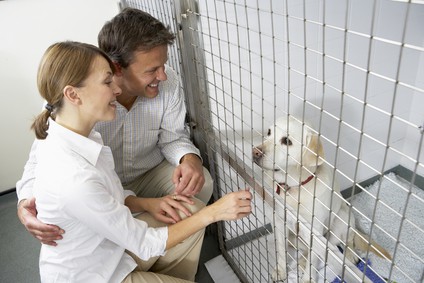There’s nothing quite as rewarding as owning (or being owned by) a dog. Your children have crossed the toddler phase and the notion of a dog, from just being the odd random thought, has now increasingly become a yearning.

Besides, there are so many shelter dogs that desperately need a home. You have discussed this with your spouse and … there’s agreement.
But before you rush out to your local shelter you must know that the temperament of the dog you adopt is critical to your joint future.
Shelter dogs, though not all of them necessarily, have had it tough. Often, they have been rescued, sometime from particularly nasty “puppy mills”.
The key period when socialization occurs — from around 4 to 14 weeks of age — could well have been spent less than ideally. Many factors come to bear in deciding a dog’s temperament; this socialization period is one of the critical ones. A dog that is not well socialized will simply not make an ideal family pet.
Some animal behaviorists believe that it is possible to “rescue” them from early mental and physical trauma, but you can rest assured that this will involve a lot of work and expert attention.
5 Tips For a Successful Dog Temperament Test
So, it is quite important that you be in a position to judge your potential pet’s temperament. Here are some tips to conduct a comprehensive dog temperament test.
1. Assess Existing Information
Most shelters maintain animal history. Examine your prospect’s file for age, sex, owner history and medical history (including whether neutered).
Further, look for indicators of behavior:
- Were there any incidents of aggression against people?
- Aggression against other animals?
- Was the animal previously placed in a family like yours?
- What was the reason the animal was given up?
2. Prepare for the Dog Temperament Test

- Professional. Ideally, the test should be conduct by an animal behaviorist, with your help. In any case, in part for safety but also for objectivity, make sure that at least two persons are involved.
- Location. The test should be conducted in a relatively quiet setting that is secure.
- Tools of the trade. The shelter could well have all of these: collar, leash, food bowl, snacks, toys, ball.
3. Take Your Time
Allow some time for the dog to settle down. Most dogs will want to explore the room at adjust to the new surroundings and the strangers present.
5 to 10 minutes works for most dogs, during which time it’s best to maintain a neutral conversation with your partner.
4. Conduct the Basic Tests
It’s important that the tester maintain a confident and friendly, but not dominant attitude. Note reactions to the following :
Entering her personal space
○ Challenge: Approach the dog while softly talking to her.
○ Ideal Response: She should look at you, possibly wagging her tail, accepting you into her personal space. She may even approach you in a friendly manner.
○ Comments: You may not get the ideal response, but any sign of aggression at this point should be considered a fatal flaw; the dog should be rejected and no further tests should be carried out.
Petting
○ Challenge: Pet gently starting with the back, then moving to the head.
○ Ideal Response: She should accept your handling, possibly wagging her tail.
○ Comments: She may back away from your touch; that signifies fearfulness and is not a good sign. As before, any sign of aggression should result in rejection with testing discontinued.
Physical examination
○ Challenge: Carefully examine the mouth, initially just petting, then gradually attempting to open the jaws making no attempt to force the issue.
○ Ideal Response: She accepts the examination stoically.
○ Comments: Slight resistance is normal. Significant resistance and/or aggression is cause for rejection.
Attempt to get her to lie down
○ Challenge: Gently ease the dog to the floor by applying pressure to the hind legs and back, then, without haste, attempt to get her to lie on her side. Keep her there for a while while gently playing with her paws before attempting to examine them.
○ Ideal Response: She accepts the manipulation and examination stoically.
○ Comments: Again, a certain amount of resistance is normal. Significant resistance and/or aggression is cause for rejection.
Walking on a leash
○ Challenge: Gently urge her to follow you with “happy” words and a light tug on the leash.
○ Ideal Response: She should happily follow you around.
○ Comments: An untrained dog may lead the way; that’s fine. There could be some initial hesitation, but significant resistance and/or aggression is cause for rejection.
Toy Retrieval
○ Challenge: The idea here is to give her a toy, see what she does with it, then try to get it back after a minute or so.
○ Ideal Response: She should accept the toy, possibly play with it a little. She should allow retrieval of the toy.
○ Comments: The toy may not evoke any response; in that case, you could try a different toy. No response to a toy is fine; some animals just don’t like them. Minor resistance during retrieval of the toy is acceptable; but any signs of aggression — growling, baring teeth — is cause for rejection and abandonment of further testing.
Food Test
○ Challenge: Put a treat in a bowl and place it on the floor near her, gently calling her to it. After a minute or so when the dog is done, carefully retrieve the bowl without making any sudden movements.
○ Ideal Response: She should approach the food, sniff it and, possibly, eat a part or all of it. There should be no response to retrieval of the bowl.
○ Comments: You should have a good feel for the dog by now, but do be careful. Any signs of aggression should result in rejection.
5. The First Few Weeks
A well-conducted dog temperament test will help you assess the dog’s suitability. However, it is by no means the last word. Most shelters offer a period — usually a few weeks — during which a further assessment of the dog can be made… at home.

Most dogs with a good temperament should show clear signs of “opening up” to the family in just two weeks or so, especially if the family shows how welcome she is by spending a lot of time with her.
A Final Word
A shelter dog that does not get adopted is usually euthanize (killed); yet, the majority of shelter dogs make excellent companions.
It makes sense to carry out a thorough dog temperament test prior to adoption; not only will this help you make the right decision; it will also avoid the additional mental stress that a failed adoption entails to a animal that is already vulnerable.

Calvin is the co-founder and one of the main contributors to dogtemperament.com. He has been an avid dog lover all his life. He enjoys researching and sharing great ideas on how you can avoid common pitfalls of dog ownership and build the most loving and enjoyable relationship with your dog.